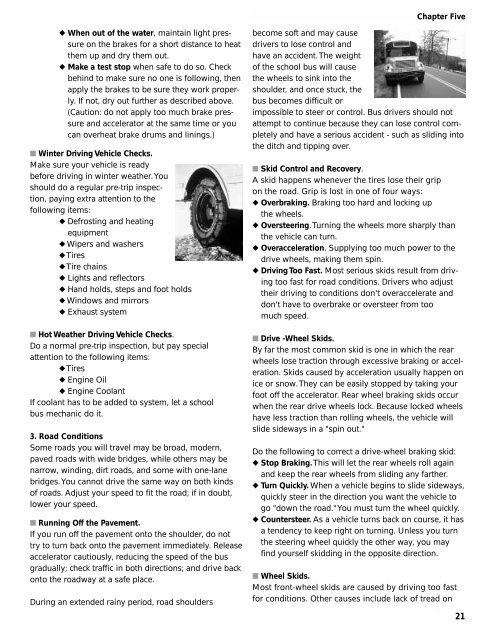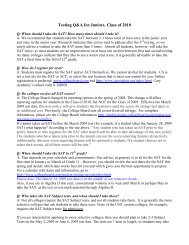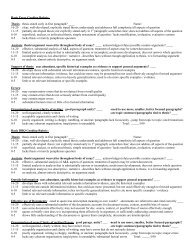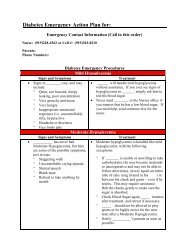Handbook - Cary Academy
Handbook - Cary Academy
Handbook - Cary Academy
Create successful ePaper yourself
Turn your PDF publications into a flip-book with our unique Google optimized e-Paper software.
Chapter Five<br />
◆ When out of the water, maintain light pressure<br />
on the brakes for a short distance to heat<br />
them up and dry them out.<br />
◆ Make a test stop when safe to do so. Check<br />
behind to make sure no one is following, then<br />
apply the brakes to be sure they work properly.<br />
If not, dry out further as described above.<br />
(Caution: do not apply too much brake pressure<br />
and accelerator at the same time or you<br />
can overheat brake drums and linings.)<br />
■ Winter Driving Vehicle Checks.<br />
Make sure your vehicle is ready<br />
before driving in winter weather. You<br />
should do a regular pre-trip inspection,<br />
paying extra attention to the<br />
following items:<br />
◆ Defrosting and heating<br />
equipment<br />
◆ Wipers and washers<br />
◆Tires<br />
◆Tire chains<br />
◆ Lights and reflectors<br />
◆ Hand holds, steps and foot holds<br />
◆ Windows and mirrors<br />
◆ Exhaust system<br />
■ Hot Weather Driving Vehicle Checks.<br />
Do a normal pre-trip inspection, but pay special<br />
attention to the following items:<br />
◆Tires<br />
◆ Engine Oil<br />
◆ Engine Coolant<br />
If coolant has to be added to system, let a school<br />
bus mechanic do it.<br />
3. Road Conditions<br />
Some roads you will travel may be broad, modern,<br />
paved roads with wide bridges, while others may be<br />
narrow, winding, dirt roads, and some with one-lane<br />
bridges. You cannot drive the same way on both kinds<br />
of roads. Adjust your speed to fit the road; if in doubt,<br />
lower your speed.<br />
■ Running Off the Pavement.<br />
If you run off the pavement onto the shoulder, do not<br />
try to turn back onto the pavement immediately. Release<br />
accelerator cautiously, reducing the speed of the bus<br />
gradually; check traffic in both directions; and drive back<br />
onto the roadway at a safe place.<br />
During an extended rainy period, road shoulders<br />
become soft and may cause<br />
drivers to lose control and<br />
have an accident. The weight<br />
of the school bus will cause<br />
the wheels to sink into the<br />
shoulder, and once stuck, the<br />
bus becomes difficult or<br />
impossible to steer or control. Bus drivers should not<br />
attempt to continue because they can lose control completely<br />
and have a serious accident - such as sliding into<br />
the ditch and tipping over.<br />
■ Skid Control and Recovery.<br />
A skid happens whenever the tires lose their grip<br />
on the road. Grip is lost in one of four ways:<br />
◆ Overbraking. Braking too hard and locking up<br />
the wheels.<br />
◆ Oversteering. Turning the wheels more sharply than<br />
the vehicle can turn.<br />
◆ Overacceleration. Supplying too much power to the<br />
drive wheels, making them spin.<br />
◆ Driving Too Fast. Most serious skids result from driving<br />
too fast for road conditions. Drivers who adjust<br />
their driving to conditions don't overaccelerate and<br />
don't have to overbrake or oversteer from too<br />
much speed.<br />
■ Drive -Wheel Skids.<br />
By far the most common skid is one in which the rear<br />
wheels lose traction through excessive braking or acceleration.<br />
Skids caused by acceleration usually happen on<br />
ice or snow. They can be easily stopped by taking your<br />
foot off the accelerator. Rear wheel braking skids occur<br />
when the rear drive wheels lock. Because locked wheels<br />
have less traction than rolling wheels, the vehicle will<br />
slide sideways in a "spin out."<br />
Do the following to correct a drive-wheel braking skid:<br />
◆ Stop Braking.This will let the rear wheels roll again<br />
and keep the rear wheels from sliding any farther.<br />
◆ Turn Quickly. When a vehicle begins to slide sideways,<br />
quickly steer in the direction you want the vehicle to<br />
go "down the road." You must turn the wheel quickly.<br />
◆ Countersteer. As a vehicle turns back on course, it has<br />
a tendency to keep right on turning. Unless you turn<br />
the steering wheel quickly the other way, you may<br />
find yourself skidding in the opposite direction.<br />
■ Wheel Skids.<br />
Most front-wheel skids are caused by driving too fast<br />
for conditions. Other causes include lack of tread on<br />
21

















